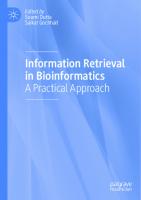Emotion and Information Processing: A Practical Approach 9783030488482
This book consists of thirteen chapters covering many facts like psycho-social intervention on emotional disorders in in
340 46 5MB
English Pages 222 [226] Year 2020
Table of contents :
Preface
Acknowledgements
Contents
About the Author
Contributors
Chapter 1: Effect of Emotion in Information Processing for Decision-Making
1.1 Five Steps in Decision-Making
1.2 Good or Bad Decision?
1.3 Act of Thinking in Decision-Making
1.4 Emotion in Decision-Making
1.5 Emotion Mediating the Information Process During the Decision-Making
1.6 Conclusion
References
Chapter 2: Impact of Psychosocial Intervention on Emotional Disorders and Medication Adherence in HIV/AIDS
2.1 Introduction
2.2 Method
2.2.1 Design
2.2.2 Ethical Concern
2.2.3 Procedure
2.2.4 Measures
2.2.5 Statistical Analysis
2.3 Result
2.3.1 Clinical Descriptions
2.3.1.1 Case 1
2.3.1.2 Case 2
2.3.1.3 Cases 3 and 4
2.3.1.4 Case 5
2.3.1.5 Case 6
2.4 Discussion
2.4.1 Limitation and Future Direction
2.4.2 Implication and Contribution
References
Chapter 3: Blended Learning and Its Impact on Cognition and Emotion
3.1 Introduction
3.1.1 Blended Learning
3.1.2 Learning Platforms
3.1.3 Blended Learning types
3.1.4 Advantages of Blended Learning
3.1.5 Blended Learning in the Workplace
3.1.6 Reasons Why Blended Learning Is Effective
3.1.7 Power of Audio-Visual Medium
3.1.8 AI a Game Changer
3.2 Emotional States and Learning Outcomes
3.2.1 Is There Any Cognitive and Emotional Link Connecting These Two to Online Learning?
3.2.2 Retrieval
3.2.3 Spaced Retrieval
3.2.4 Heightened Attention Level
3.2.5 Challenge
References
Chapter 4: Theory and Implications of Information Processing
4.1 Introduction
4.2 The Emergence of Information Processing
4.3 Theories of Information Processing
4.3.1 Levels of Processing
4.3.2 Dual Coding Theory
4.3.3 Schema Theory, Parallel Distributed Processing, and Connectionist Models
4.4 Types of Information Processing
4.4.1 Natural Information Processing System
4.5 Technical Information Processing System
4.5.1 Stages of Information Processing Cycle
4.6 Memory
4.6.1 The Stage Model
4.6.2 Sensory Memory
4.6.3 Short-Term or Working Memory
4.7 Computer–Mind Analogy (Fig. 4.3)
4.7.1 How Does Psychology Relate to Information Processing?
4.7.2 Metacognition
4.8 Implications and Applications of Information Processing
4.9 Summary
References
Chapter 5: Effect on the Emotional Self-Esteem of Women with Reference to Make-Up
5.1 Introduction
5.2 Objectives of the Study
5.3 Literature Review
5.4 Conceptual Framework
5.5 Hypothesis
5.6 Methodology
5.7 Data Analysis
5.7.1 Finding out the Response Rate (Table 5.1)
5.7.2 Finding out Descriptive Statistics
5.7.2.1 Frequencies (Table 5.2)
5.7.3 Reliability
5.7.4 Using Mean and Standard Deviation
5.7.5 Hypothesis 1
5.7.6 Using Correlation and Regression Analysis
5.7.7 Using Regression to Prove Hypothesis
5.7.8 Hypothesis 2
5.7.9 Using Correlation and Regression Analysis
5.7.10 Using Regression to Prove Hypothesis
5.7.11 Hypothesis 3
5.7.12 Using Correlation Analysis
5.7.13 Using Regression to Prove Hypothesis
5.7.14 Hypothesis 4
5.7.15 Using Correlation and Regression Analysis
5.7.16 Using Regression to Prove Hypothesis
5.8 Findings
5.9 Conclusion
5.10 Limitations
5.11 Recommendations
References
Chapter 6: Behavioral and Emotional Dimensions of Sexual Harassment at Workplace
6.1 Introduction
6.1.1 Start of the MeToo Movement
6.2 Review of Literature
6.3 Objectives
6.4 Research Methodology
6.5 Hypothesis Testing and Analysis
6.6 Conclusion
Annexure
References
Chapter 7: The Effect of Age, Gender, and Arousal Level on Categorizing Human Affective States
7.1 Introduction
7.2 Application Domain of Speech Emotion Characterization
7.2.1 Tutoring System
7.2.2 Lie Detection
7.2.3 Banking
7.2.4 Recruitments
7.2.5 Security
7.2.6 In-Car Board System
7.2.7 Prosody in Dialog System
7.2.8 Emotion Recognition in Call Center
7.2.9 Voice Mail
7.2.10 Computer Games/Web Movies
7.2.11 Diagnostic Tool by Speech Therapists
7.2.12 Robots
7.3 Feature Extraction
7.3.1 Spectrum Variance
7.3.2 Cepstrum Magnitude
7.3.3 Autocorrelation Coefficients (ACF)
7.3.4 Pitch or Fundamental Frequency (F0)
7.3.5 Speech Rate
7.3.6 Zero-Crossing Rate (ZCR)
7.3.7 Log Energy
7.3.8 Spectral Centroid (SC)
7.3.9 Spectral Flux (SF)
7.3.10 Spectral Roll-Off (SR)
7.3.11 Skewness
7.3.12 Kurtosis
7.3.13 Shannon Entropy
7.3.14 Features of the Vocal Tract Model
7.3.14.1 Mel-Frequency Cepstral Coefficient (MFCC)
7.3.14.2 Linear Predictor Cepstral Coefficient (LPCC)
7.3.14.3 Perceptual Linear Predictor (PLP) Coefficient
7.3.14.4 Formants
7.4 Results and Discussion
7.5 Conclusions
References
Chapter 8: Embarrassment in the Context of Negative Emotions and Its Effects on Information Processing
8.1 Introduction
8.2 Embarrassment and Embarrassability
8.3 Embarrassment and Related Emotions
8.4 Embarrassment: Antecedents and Consequences
8.4.1 Antecedents
8.4.1.1 Biological
8.4.1.2 Psychological
8.4.1.3 Social
8.4.2 Outcomes
8.4.2.1 Biological
8.4.2.2 Psychological
8.4.2.3 Social
8.5 Gender Differences in Experiencing Embarrassment
8.5.1 Gender Roles
8.5.2 Stereotypical Behaviours
8.5.3 Age
8.5.4 Self-Report
8.5.5 Situational Context
8.5.6 Interpersonal Context
8.6 Experiencing Embarrassment Versus Experiencing Related Negative Emotions: Distinction Based on Gender Differences
8.6.1 Is Embarrassment as Simple an Emotion as It Is Considered to Be?
8.7 Embarrassment and Information Processing
8.8 Placing Individuals on the Embarrassment Continuum
8.8.1 Personal Factors of an Individual
8.8.2 Nature of the Situation
8.8.3 Social Support
8.9 Limitations
8.10 Implications and Future Scope
8.11 Conclusion
References
Chapter 9: Student’s Emotion: The Power of Emotion Education in School
9.1 Introduction
9.2 Role of Education in Children’s Emotional Development
9.3 Emotional Attachment, Cognition, and Behavior
9.4 Emotional Coaching Strategy for Promoting Sustainable Emotional and Behavioral Well-Being
9.5 Teacher–Student Attachment and Emotional Development
9.6 Emotional Competence, Emotional Intelligence, and Emotional Literacy
9.7 Emotion and Attitude Development
9.8 Social-Emotional Development and Cooperative Learning
9.9 Emotional Labor and Education
9.10 Conclusion
References
Chapter 10: Emotional Level Classification and Prediction of Tweets in Twitter
10.1 Introduction
10.2 Related Works
10.3 System Architecture
10.4 Data Collection
10.5 Data Preprocessing
10.6 Feature Extraction
10.6.1 Unigram
10.6.2 Unigram with POS Tagging
10.6.3 Bab of Words (BOW)
10.7 Proposed Classifier
10.7.1 Disadvantage of Existing Model
10.7.2 Proposed Model
10.8 Result and Analysis
10.9 Conclusion
References
Chapter 11: Remaining Useful Life as a Cognitive Tool in the Domain of Manufacturing
11.1 Introduction
11.2 Related Past Literary Works
11.2.1 Philosophy of Decision-Making with a Weight Towards Cognition
11.2.2 Maintenance-Based Monitoring
11.2.3 Modelling Techniques and Algorithm Used for RUL Estimation
11.3 Methodology and Results
11.4 Conclusion
References
Chapter 12: Multiple Task Human Gait Analysis and Identification: Ensemble Learning Approach
12.1 Introduction
12.2 Proposed Work
12.2.1 Dataset Description and Methodology
12.3 Algorithm
12.3.1 Extreme Learning Machine Algorithm
12.3.2 Support Vector Machines (SVM)
12.3.3 k-Nearest Neighbor (KNN)
12.3.4 Principal Component Analysis (PCA)
12.3.5 Ensemble Learning
12.4 Results and Discussions
12.5 Conclusions
References
Chapter 13: Employing Machine Learning for Multi-perspective Emotional Health Analysis
13.1 Introduction
13.2 Emotional Health Analysis
13.2.1 Emotion Analysis Using Text Processing
13.2.2 Emotion Analysis Using Speech Processing
13.2.3 Emotion Analysis Using Behavior Perception
13.3 Comparative Analysis of Various Perspectives
13.4 Case Studies
13.5 Conclusion and Future Work
References
Index
Preface
Acknowledgements
Contents
About the Author
Contributors
Chapter 1: Effect of Emotion in Information Processing for Decision-Making
1.1 Five Steps in Decision-Making
1.2 Good or Bad Decision?
1.3 Act of Thinking in Decision-Making
1.4 Emotion in Decision-Making
1.5 Emotion Mediating the Information Process During the Decision-Making
1.6 Conclusion
References
Chapter 2: Impact of Psychosocial Intervention on Emotional Disorders and Medication Adherence in HIV/AIDS
2.1 Introduction
2.2 Method
2.2.1 Design
2.2.2 Ethical Concern
2.2.3 Procedure
2.2.4 Measures
2.2.5 Statistical Analysis
2.3 Result
2.3.1 Clinical Descriptions
2.3.1.1 Case 1
2.3.1.2 Case 2
2.3.1.3 Cases 3 and 4
2.3.1.4 Case 5
2.3.1.5 Case 6
2.4 Discussion
2.4.1 Limitation and Future Direction
2.4.2 Implication and Contribution
References
Chapter 3: Blended Learning and Its Impact on Cognition and Emotion
3.1 Introduction
3.1.1 Blended Learning
3.1.2 Learning Platforms
3.1.3 Blended Learning types
3.1.4 Advantages of Blended Learning
3.1.5 Blended Learning in the Workplace
3.1.6 Reasons Why Blended Learning Is Effective
3.1.7 Power of Audio-Visual Medium
3.1.8 AI a Game Changer
3.2 Emotional States and Learning Outcomes
3.2.1 Is There Any Cognitive and Emotional Link Connecting These Two to Online Learning?
3.2.2 Retrieval
3.2.3 Spaced Retrieval
3.2.4 Heightened Attention Level
3.2.5 Challenge
References
Chapter 4: Theory and Implications of Information Processing
4.1 Introduction
4.2 The Emergence of Information Processing
4.3 Theories of Information Processing
4.3.1 Levels of Processing
4.3.2 Dual Coding Theory
4.3.3 Schema Theory, Parallel Distributed Processing, and Connectionist Models
4.4 Types of Information Processing
4.4.1 Natural Information Processing System
4.5 Technical Information Processing System
4.5.1 Stages of Information Processing Cycle
4.6 Memory
4.6.1 The Stage Model
4.6.2 Sensory Memory
4.6.3 Short-Term or Working Memory
4.7 Computer–Mind Analogy (Fig. 4.3)
4.7.1 How Does Psychology Relate to Information Processing?
4.7.2 Metacognition
4.8 Implications and Applications of Information Processing
4.9 Summary
References
Chapter 5: Effect on the Emotional Self-Esteem of Women with Reference to Make-Up
5.1 Introduction
5.2 Objectives of the Study
5.3 Literature Review
5.4 Conceptual Framework
5.5 Hypothesis
5.6 Methodology
5.7 Data Analysis
5.7.1 Finding out the Response Rate (Table 5.1)
5.7.2 Finding out Descriptive Statistics
5.7.2.1 Frequencies (Table 5.2)
5.7.3 Reliability
5.7.4 Using Mean and Standard Deviation
5.7.5 Hypothesis 1
5.7.6 Using Correlation and Regression Analysis
5.7.7 Using Regression to Prove Hypothesis
5.7.8 Hypothesis 2
5.7.9 Using Correlation and Regression Analysis
5.7.10 Using Regression to Prove Hypothesis
5.7.11 Hypothesis 3
5.7.12 Using Correlation Analysis
5.7.13 Using Regression to Prove Hypothesis
5.7.14 Hypothesis 4
5.7.15 Using Correlation and Regression Analysis
5.7.16 Using Regression to Prove Hypothesis
5.8 Findings
5.9 Conclusion
5.10 Limitations
5.11 Recommendations
References
Chapter 6: Behavioral and Emotional Dimensions of Sexual Harassment at Workplace
6.1 Introduction
6.1.1 Start of the MeToo Movement
6.2 Review of Literature
6.3 Objectives
6.4 Research Methodology
6.5 Hypothesis Testing and Analysis
6.6 Conclusion
Annexure
References
Chapter 7: The Effect of Age, Gender, and Arousal Level on Categorizing Human Affective States
7.1 Introduction
7.2 Application Domain of Speech Emotion Characterization
7.2.1 Tutoring System
7.2.2 Lie Detection
7.2.3 Banking
7.2.4 Recruitments
7.2.5 Security
7.2.6 In-Car Board System
7.2.7 Prosody in Dialog System
7.2.8 Emotion Recognition in Call Center
7.2.9 Voice Mail
7.2.10 Computer Games/Web Movies
7.2.11 Diagnostic Tool by Speech Therapists
7.2.12 Robots
7.3 Feature Extraction
7.3.1 Spectrum Variance
7.3.2 Cepstrum Magnitude
7.3.3 Autocorrelation Coefficients (ACF)
7.3.4 Pitch or Fundamental Frequency (F0)
7.3.5 Speech Rate
7.3.6 Zero-Crossing Rate (ZCR)
7.3.7 Log Energy
7.3.8 Spectral Centroid (SC)
7.3.9 Spectral Flux (SF)
7.3.10 Spectral Roll-Off (SR)
7.3.11 Skewness
7.3.12 Kurtosis
7.3.13 Shannon Entropy
7.3.14 Features of the Vocal Tract Model
7.3.14.1 Mel-Frequency Cepstral Coefficient (MFCC)
7.3.14.2 Linear Predictor Cepstral Coefficient (LPCC)
7.3.14.3 Perceptual Linear Predictor (PLP) Coefficient
7.3.14.4 Formants
7.4 Results and Discussion
7.5 Conclusions
References
Chapter 8: Embarrassment in the Context of Negative Emotions and Its Effects on Information Processing
8.1 Introduction
8.2 Embarrassment and Embarrassability
8.3 Embarrassment and Related Emotions
8.4 Embarrassment: Antecedents and Consequences
8.4.1 Antecedents
8.4.1.1 Biological
8.4.1.2 Psychological
8.4.1.3 Social
8.4.2 Outcomes
8.4.2.1 Biological
8.4.2.2 Psychological
8.4.2.3 Social
8.5 Gender Differences in Experiencing Embarrassment
8.5.1 Gender Roles
8.5.2 Stereotypical Behaviours
8.5.3 Age
8.5.4 Self-Report
8.5.5 Situational Context
8.5.6 Interpersonal Context
8.6 Experiencing Embarrassment Versus Experiencing Related Negative Emotions: Distinction Based on Gender Differences
8.6.1 Is Embarrassment as Simple an Emotion as It Is Considered to Be?
8.7 Embarrassment and Information Processing
8.8 Placing Individuals on the Embarrassment Continuum
8.8.1 Personal Factors of an Individual
8.8.2 Nature of the Situation
8.8.3 Social Support
8.9 Limitations
8.10 Implications and Future Scope
8.11 Conclusion
References
Chapter 9: Student’s Emotion: The Power of Emotion Education in School
9.1 Introduction
9.2 Role of Education in Children’s Emotional Development
9.3 Emotional Attachment, Cognition, and Behavior
9.4 Emotional Coaching Strategy for Promoting Sustainable Emotional and Behavioral Well-Being
9.5 Teacher–Student Attachment and Emotional Development
9.6 Emotional Competence, Emotional Intelligence, and Emotional Literacy
9.7 Emotion and Attitude Development
9.8 Social-Emotional Development and Cooperative Learning
9.9 Emotional Labor and Education
9.10 Conclusion
References
Chapter 10: Emotional Level Classification and Prediction of Tweets in Twitter
10.1 Introduction
10.2 Related Works
10.3 System Architecture
10.4 Data Collection
10.5 Data Preprocessing
10.6 Feature Extraction
10.6.1 Unigram
10.6.2 Unigram with POS Tagging
10.6.3 Bab of Words (BOW)
10.7 Proposed Classifier
10.7.1 Disadvantage of Existing Model
10.7.2 Proposed Model
10.8 Result and Analysis
10.9 Conclusion
References
Chapter 11: Remaining Useful Life as a Cognitive Tool in the Domain of Manufacturing
11.1 Introduction
11.2 Related Past Literary Works
11.2.1 Philosophy of Decision-Making with a Weight Towards Cognition
11.2.2 Maintenance-Based Monitoring
11.2.3 Modelling Techniques and Algorithm Used for RUL Estimation
11.3 Methodology and Results
11.4 Conclusion
References
Chapter 12: Multiple Task Human Gait Analysis and Identification: Ensemble Learning Approach
12.1 Introduction
12.2 Proposed Work
12.2.1 Dataset Description and Methodology
12.3 Algorithm
12.3.1 Extreme Learning Machine Algorithm
12.3.2 Support Vector Machines (SVM)
12.3.3 k-Nearest Neighbor (KNN)
12.3.4 Principal Component Analysis (PCA)
12.3.5 Ensemble Learning
12.4 Results and Discussions
12.5 Conclusions
References
Chapter 13: Employing Machine Learning for Multi-perspective Emotional Health Analysis
13.1 Introduction
13.2 Emotional Health Analysis
13.2.1 Emotion Analysis Using Text Processing
13.2.2 Emotion Analysis Using Speech Processing
13.2.3 Emotion Analysis Using Behavior Perception
13.3 Comparative Analysis of Various Perspectives
13.4 Case Studies
13.5 Conclusion and Future Work
References
Index

![Emotion and Information Processing: A Practical approach [1st ed.]
9783030488482, 9783030488499](https://ebin.pub/img/200x200/emotion-and-information-processing-a-practical-approach-1st-ed-9783030488482-9783030488499.jpg)

![Hexagonal Image Processing. A Practical Approach [1st Edition.]
9781852339142, 1852339144](https://ebin.pub/img/200x200/hexagonal-image-processing-a-practical-approach-1st-edition-9781852339142-1852339144.jpg)






